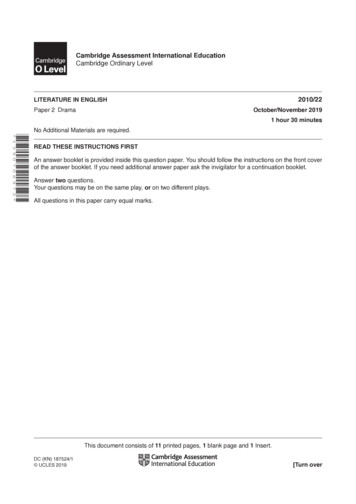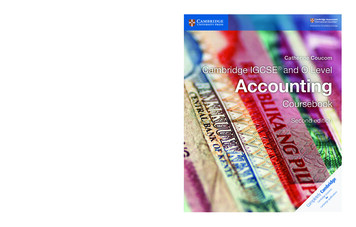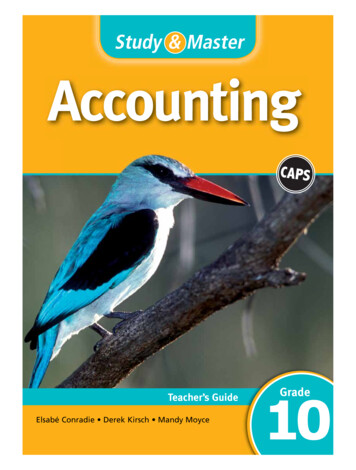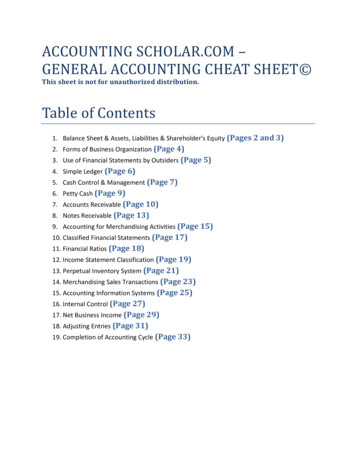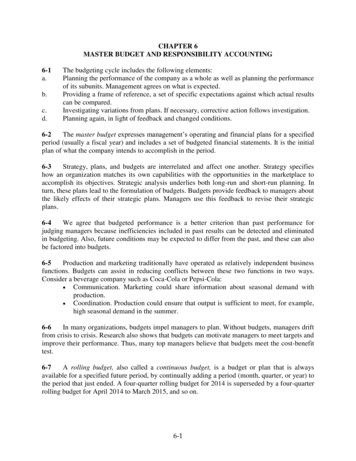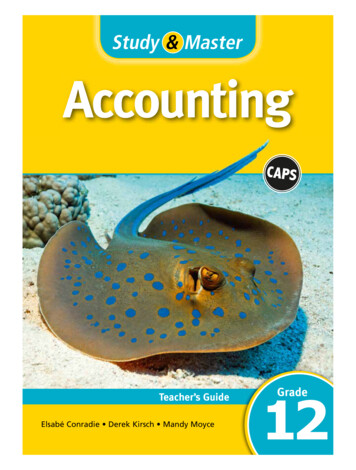
Transcription
Study & MasterAccountingCAPSTeacher’s GuideElsabé Conradie Derek Kirsch Mandy MoyceSM Accounting 12 TG CAPS ENG.indd 1GradeGrade12122013/06/06 3:45 PM
Study & MasterAccountingGrade 12Teacher’s GuideElsabé Conradie Derek Kirsch Mandy MoyceConsultant: Sophia M. Brink CA(SA) MCom.TaxAcc12 TG Book (12).indb 1SM Accounting 12 TG TP CAPS ENG.indd16/6/13 4:52:192013/06/063:41PMPM
cambridge university pressCambridge, New York, Melbourne, Madrid, Cape Town,Singapore, São Paulo, Delhi, Mexico CityCambridge University PressThe Water Club, Beach Road, Granger Bay, Cape Town 8005, South Africawww.cup.co.za Cambridge University Press 2013This publication is in copyright. Subject to statutory exceptionand to the provisions of relevant collective licensing agreements,no reproduction of any part may take place without the writtenpermission of Cambridge University Press.First published 2013ISBN 978-1-107-38172-8Editor: Christine de NobregaTypesetter: Brink Publishing and DesignIllustrator: Warren Brink (Brink Publishing)Cover image: Fotostock SA Cambridge University Press has no responsibility for the persistence oraccuracy of URLs for external or third-party internet websites referred to inthis publication, and does not guarantee that any content on such websites is,or will remain, accurate or appropriate. Information regarding prices, traveltimetables and other factual information given in this work are correct atthe time of first printing but Cambridge University Press does not guaranteethe accuracy of such information thereafter. notice to teachersThe photocopy masters in this publication may be photocopied ordistributed [electronically] free of charge for classroom use within theschool or institution which purchases the publication. Worksheets andcopies of them remain in the copyright of Cambridge University Pressand such copies may not be distributed or used in any way outside thepurchasing institution. If you want to know more about this book or any other Cambridge University Presspublication, phone us at 27 21 4127800, fax us at 27 21 419-8418 or send an e-mail tocapetown@cambridge.orgAcc 12 TG Book (12).indb 26/6/13 4:52:19 PM
ContentsSection 1 Introduction 1Section 2 PlanningAnnual Teaching Plan 9Daily Teaching Plan 10Section 3 Assessment tasks1. Written reports 212. Controlled tests 393. Projects 624. Examinations 655. Case studies 151Section 4 Notes/tips for teachers161Section 5 Powerpoint PresentationsSection 6 Solutions to activitiesChapter 1: Financial accounting of companies –concepts, unique ledger accounts and bookkeeping 173Chapter 2: Financial accounting of companies –Final accounts, Post-closing Trial Balance, IFRS and GAAP 191Chapter 3: Financial accounting of companies – Financial statements 203Chapter 4: Financial accounting of companies –analysis and interpretation of financial statements 235Chapter 5: Financial accounting of companies –analysis of published financial statements 252Chapter 6: Ethics 258Chapter 7: Interpretation and reporting on the movement of fixed assets 263Chapter 8: Financial accounting of close corporations 270Chapter 9: Internal control 272Chapter 10: Inventory systems 276Chapter 11: Reconciliations 289Chapter 12: Value-added Tax (VAT) 305Chapter 13: Cost Accounting and manufacturing businesses 318Chapter 14: Budgeting 343Chapter 15: Revision activities 367Section 7 Moderation templatesSection 8 Answer sheet templatesAcc 12 TG Book (12).indb 34054136/6/13 4:52:19 PM
Section 1introduction1. Subject objectivesIt is essential that learners be made aware of the importance of Accounting andits relevant application in modern-day career choices where entrepreneurialskills are so vitally important. There should also be a concerted effort tonurture an interest and passion for this subject in every learner.Every learner should have their individual talents and abilities taken intoaccount so that this interest may be developed to each one‘s own full potential.When teaching this subject, the following objectives should be achieved: To link the learners’ prior knowledge to the new subject content throughprogression To approach the content in a meaningful manner with sufficient referenceto real-life situations To present the content in such a way that learners understand the content,rather than just memorise subject matter To use a variety of presentation strategies To keep regular control over written work and to ensure that meaningfulevaluations take place To provide regular homework tasks so that learners can consolidate andrevise their work in this manner.Moreover, it is our aim to convey to learners the knowledge and skills thatwill provide an appropriate basis from which to build a successful career orcontinue their studies in this subject area.2. Books and portfolios2.1 Exercise booksWe recommend that learners should acquire the following exercise books forGrade 12 Accounting: A General Ledger An eight-column journal A three-column cash book.A workbook is available in which all the columns for each activity are alreadydrawn, and which will save considerable time, but not all learners will be ableto afford this.2.2 Learner portfoliosA B4 envelope will serve the purpose of a learner’s portfolio very well. Ittakes up very little space in the classroom, is inexpensive and ensures that theassessment tasks of every learner are available for moderation in class in anordered manner. The following information needs to appear on front of theenvelope: Name and surname of the learner; grade and section; learning areaand grade; subject teacher.section 1 introductionAcc 12 TG Book (12).indb 116/6/13 4:52:19 PM
The portfolio also needs to contain the following divisions: Summaries / content / intervention page with statement of authenticity Control tests Examinations Case studies / presentations Project Informal assessments.2.3 Intervention with learnersIf a learner is repeatedly performing poorly or is creating problems, his or herparents or caregivers need to be contacted. Any interaction with the parentsshould be via letter or telephone, a record needs to be kept of all interactionand has to be forwarded to the relevant grade supervisor.You should try to be available for extra classes for at least one hour per week– carefully record this as learner intervention.The portfolios should never leave the classroom – the same applies to theworksheets once they have been placed in the portfolio. After every test orCASS activity, the learner intervention sheet (front page of the portfolio)needs to be sent to the parents for signature – this is to keep parentscontinually informed of the learner’s marks. Any intervention with theparent/learner should also be recorded on this sheet, if the parent shouldvisit you during a parent evening.2.4 Teacher portfoliosThis portfolio should contain the following: Front page with relevant information Table of contents Subject guidelines Teacher timetable Mark sheets (the following information has to be indicated: Subject /learning area, grade, learner’s name and marks, date of completion forformal task, assessment sheet / subject of task / maximum mark that canbe achieved) Assessment programmes Yearly planner and daily planner Proof of moderation (internal and external) Policy documents (Curriculum and Assessment Policy Statement forAccounting, The National Protocol for Assessment Grades R-12, NationalPolicy pertaining to the Programme and Promotion Requirements of theNational Curriculum statements Grades R-12, Education White Paper 6,Special Needs Education (May 2001) Sections for the following:Accounting: Control tests, examinations, case studies, written reports,projects, informal assessmentsThe assessment matrix for both the exam paper and the markingmemorandum should be included with each section Learner information and interaction with parents / intervention Departmental information and circulars (Continuous AssessmentGuidelines document and Learning Areas / Subject guidelines) Memoranda of subject meetings.2Acc 12 TG Book (12).indb 2section 1 introduction6/6/13 4:52:19 PM
3. What is Accounting?From CAPS documentAccounting focuses on measuring performance and processing andcommunicating financial information about economic sectors. Thediscipline ensures that principles such as ethical behaviour, transparencyand accountability are adhered to. It deals with the logical, systematic andaccurate selection and recording of financial information and transactions,as well as the compilation, analysis, interpretation and communication offinancial statements and managerial reports for use by interested parties.The subject encompasses accounting knowledge, skills and values the focuson the financial accounting, managerial accounting and auditing fields.These fields cover a broad spectrum of accounting concepts and skills toprepare learners for a variety of career opportunities.The table below indicates the main topics in the Accounting curriculum.CurriculumTopic1. Accounting concepts (terminology, definitions, doubleentry, etc.)2. GAAP . Bookkeeping (source documents, journals, ledgers,Trial Balances, etc.)4. Accounting equation5. Final accounts and financial statements (includingadjustments and ratios)6. Salaries and wages7. Value-added tax (VAT)8. Reconciliations (bank, debtors and Managingresources(weighting:20–25%)9. Cost accounting (manufacturing, etc.)10. Budgeting11. Indigenous bookkeeping systems (Grade 10 only)12. Fixed assets13. Inventory14. Ethics15. Internal controls4. The purpose of AccountingFrom CAPS documentAccounting learners will be able to: record, analyse and interpret financial and other relevant data in order tomake informed decisions present and/or communicate financial information effectively by usingGenerally Accepted Accounting Practices (GAAP) in line with currentdevelopments and legislation develop and demonstrate an understanding of fundamental accountingconcepts relate skills, knowledge and values to real-life situations in order to ensurethe balance between theory and practice, in order to enter the worldof work and/or to move to higher education, and to encourage selfdevelopmentsection 1 introductionAcc 12 TG Book (12).indb 336/6/13 4:52:19 PM
organise and manage their own finances and activities responsibly andeffectively apply principles to solve problems in a judicious and systematic manner infamiliar and unfamiliar situations, thus developing the ability to identifyand solve problems in the context of the various fields of Accounting develop critical, logical and analytical abilities and thought processes toenable learners to apply skills to current and new situations develop the following characteristics:– ethical behaviour– sound judgement– thoroughness– orderliness– accuracy– neatness deal confidently with the demands of an accounting occupation manuallyand/or electronically.5. Time allocation for Accounting on the timetableFrom CAPS documentThe teaching time for Accounting is 4 hours per week per grade on thetimetable; that is, for Grades 10, 11 and 12.6. Requirements to offer Accounting as a subjectFrom CAPS documentIt is the responsibility of the school to provide the resources needed to offerAccounting as a subject.6.1 Each learner should have:6.1.1 A textbook6.1.2 Accounting stationery or a workbook6.1.3 A calculator.6.2 The teacher should have:6.2.1 A variety of textbooks to be used as references6.2.2 Policies, e.g. a summary of the King Code III6.2.3 A partnership agreement6.2.4 Legislation, e.g. Companies Act No. 71 of 20086.2.5 Codes of professional bodies, e.g. SAICA and SAIPA Codes6.2.6 SARS brochures6.2.7 Bank brochures6.2.8 Access to a computer and the Internet.4Acc 12 TG Book (12).indb 4section 1 introduction6/6/13 4:52:19 PM
7. Overview and progression of topicsTOPICGrade 10Grade 11Grade 12IndigenousbookkeepingsystemsComparison of bookkeepingsystems of the informal and formalsectorsNoneNoneEthicsCode of ethics and basic principlesof ethics for businessesIdentification and analysis ofethical behaviour applicableto financial environments withreference to accountability,transparency and sustainability Role of professional bodies foraccountants Disciplinary and punitivemeasures for non-compliancewith code of conduct Policies governing ethicalbehaviour, viz. King Code III Basic principles of theCompanies ActGAAP principlesApplicable to sole tradersApplicable to partnerships andnon-profit organisations (clubs)Applicable to companiesInternal controlBasic internal control processesDemonstration of knowledgeof internal audit processes, viz.division of duties, documentation,physical controls and internalaudit Application of internal controland internal audit processes in abusiness environment Understanding of the differencebetween the roles of internaland external auditorsAccountingconceptsConcepts related to sole tradersConcepts related to partnershipsand clubsConcepts related to companiesand manufacturersBookkeepingBookkeeping process for soletradersUnique entries and accounts forpartnerships and clubsUnique entries and accounts forcompaniesReconciliationsPreparation of debtors andcreditors lists to reconcile withthe debtors and creditors controlaccountsPreparation of reconciliationstatements by reconciling to bankand creditors statementsAnalysis and interpretation ofbank, debtors and creditorsreconciliations and age analysisAccountingequationAnalysis of transactions of soletradersAnalysis of transactions ofpartnerships and clubsAnalysis of transactions ofcompaniesValue-addedTaxConcepts of Value-added TaxCalculations of Value-added TaxLedger accounts of Value-addedTaxSalaries andwagesExplanation, calculation andrecording of salary an
Section 6 solutIons to actIvItIes Chapter 1: Financial accounting of companies – concepts, unique ledger accounts and bookkeeping 173 Chapter 2: Financial accounting of companies – Final accounts, Post-closing Trial Balance, IFRS and GAAP 191 Chapter 3: Financial accounting of companies – Financial statements 203 Chapter 4: Financial accounting of companies – analysis and .
